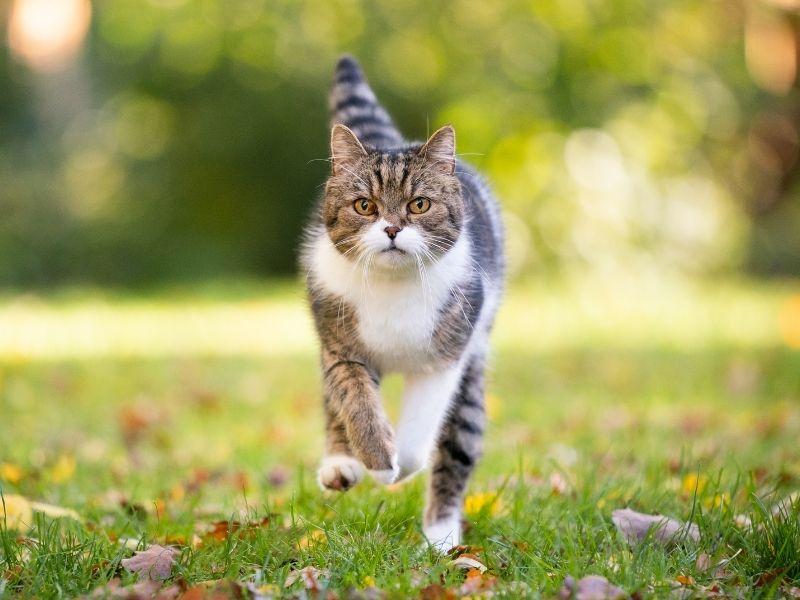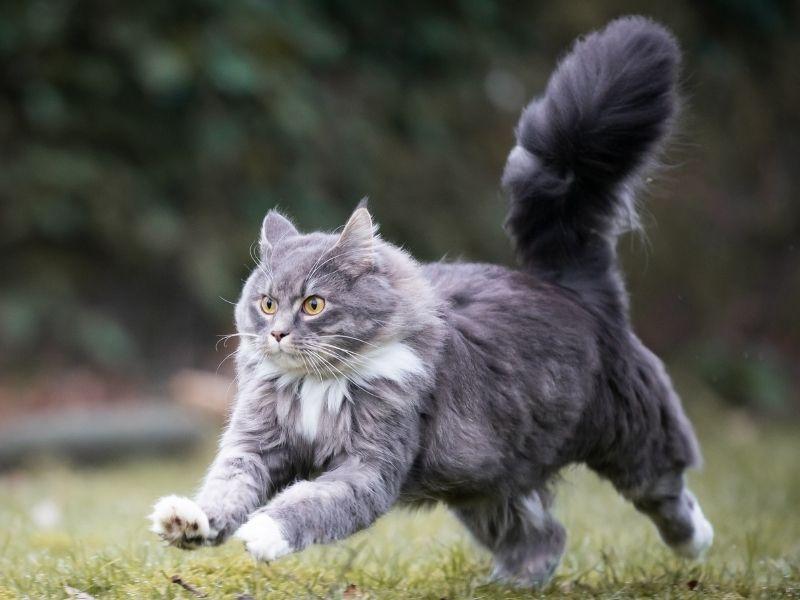Domestic cats are one of the most popular pets in the world. They are known for being independent, yet affectionate creatures. Many people wonder how fast domestic cats can run. The answer depends on several factors, including the cat’s breed, age, and weight. The average top speed of a domestic cat is 30 miles per hour (mph). However, some cats can run as fast as 35 mph. The record for the fastest cat belongs to a domestic Shorthair named Creme Puff, who ran at a speed of 38 mph in 1968. However, it’s important to note that most cats cannot sustain their top speed for more than a few seconds.
Are House Cats Faster Than Dogs?
No, house cats are not faster than dogs. The fastest speed for a dog is around 45 mph, this being the Greyhound, which is much faster than the top speed of a domestic cat. However, it’s important to remember that different breeds of both cats and dogs can vary in speed. For example, some small breeds of dogs may only be able to run as fast as 15 – 20 mph, while some larger breeds can reach speeds of over 40 mph.
Also, some big domestic cats can run as fast as dogs. The Maine Coon is the largest domesticated cat breed and can run up to 30 mph. Small dogs like the Chihuahua and the Toy Poodle can only run up to 15 mph. For comparison, the world’s smallest dog breed, the Yorkshire Terrier, can only reach speeds of up to 7 mph.
Do Cats Prefer to Stalk or Chase Prey?
Cats are natural predators and usually prefer to stalk their prey before they attack. This allows them to get closer to their target without being seen. Once they are close enough, they will pounce on their prey and attempt to kill it. However, not all cats stalk their prey. Here are some other ways that cats may hunt:

i) Chasing
Some cats will chase their prey instead of stalking it. This is usually more common in younger cats who have not yet learned to be patient. A cat can chase its prey for a long time until it finally gets tired and makes a mistake that the cat can take advantage of.
ii) Ambushing
Another way that cats may hunt is by ambushing their prey. This involves hiding and waiting for the right moment to attack. When the prey is close enough, the cat will pounce on it and attempt to kill it. Ambushing is an effective hunting strategy because it allows the cat to surprise its prey and take it by surprise.
iii) Trapping
Some cats will trap their prey by using their bodies to block escape routes. This type of hunting is most common in larger cats, such as lions and tigers. Once the prey is trapped, the cat will attack and kill it. If the prey is too large to be killed and eaten, the cat will usually drag it away to a safe place where it can eat it in peace.
See Also: Do Domestic Cats Hunt Squirrels?
And: Do All Domestic Cats Have Retractable Claws?
Do Cats Always Run from Dogs?
Not always, cats do not always run from dogs. In fact, some cats may see a dog as a potential threat and will attack it. However, most cats will try to avoid confrontations with dogs by running away. This is because cats are usually much smaller than dogs and are not well-equipped to defend themselves. If a cat does find itself in a confrontation with a dog, it may:
i) Hiss
One way a cat may try to defend itself from a dog is by hissing. This is a warning sign that tells the dog to back off. The cat may also arch its back and raise its fur to make itself look bigger. Hissing involves the cat drawing air in through its nose and exhaling it forcefully through its mouth.
ii) Swat
Another way a cat may defend itself is by swatting at the dog with its paws. This can be dangerous for the cat, as the dog may retaliate. Swatting is a more aggressive way of telling the dog to back off.
iii) Fight
If the hissing and swatting don’t work, the cat may decide to fight the dog. This is usually a last resort, as the cat is at a disadvantage. The cat will use its claws and teeth to try to injure the dog. Big domestic cats like the Maine Coon have a better chance of winning a fight against a dog, due to their size.

Do Cats Know a Dog Can’t Climb When They Run Up a Tree?
Yes, cats know that dogs cannot climb when they run up a tree. This is because cats are able to climb trees and dogs are not. When a cat is being chased by a dog, it will often run up a tree to escape. The cat knows that the dog cannot follow and will be safe from harm. This is an instinctive behavior that all cats have.
The reason why a dog cannot climb trees is that they are not built for it. Dogs’ legs are not designed to grip a tree trunk, and their nails are not sharp enough to provide traction. Therefore, dogs are not able to climb trees as cats can.
Cats on the other side have sharp claws that help them grip tree trunks. They also have flexible bodies that make it easy for them to climb. Cats are able to climb trees because they are built for it.
House cats may not be as fast as dogs, but they are still predators that have their own way of hunting. Cats usually stalk their prey before attacking, but they can also chase or ambush their prey. Some cats will even trap their prey by blocking its escape routes. Although cats usually run from dogs, they know that dogs cannot climb trees and will often escape up a tree when being chased. Cats are built for climbing trees, with their sharp claws and flexible bodies. This is why they are able to climb trees and dogs are not.
Featured image: Maine Coon Cat with Fluffy Tail Running at Speed

